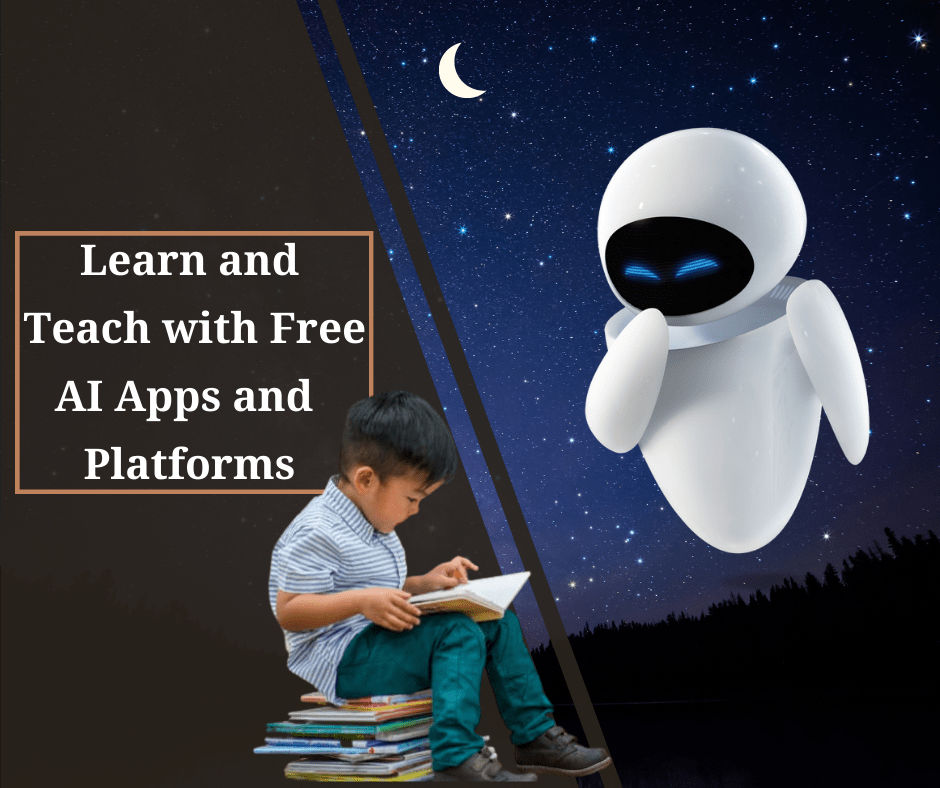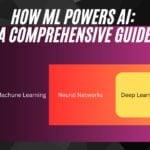Should You Use Free AI Apps and Platforms to Learn & Teach? Have you ever wondered how to use artificial intelligence (AI) in education? Do you want to enhance your learning and teaching experience with AI?
Do you want to discover the best free AI education apps and platforms that can help you learn and teach various subjects and topics, gain applicable knowledge, and acquire up-to-date skills?
If you answered ‘Yes’ to any of the above questions, then this article is for you.
In this article, we will share with you some basics of AI and how it can be used in education. We will also provide you with a comprehensive list of the best free AI education apps and platforms for learners and teachers. By the end of this article, you will have a clear idea of how to start your learning or teaching journey leveraging AI apps and platforms for free.
But before we dive into the details, let’s first understand why and how AI is important for education.

Table of Contents
Why Artificial Intelligence in Education is Important
Artificial intelligence is the science and engineering of creating machines or software that can perform tasks that normally require human intelligence, such as reasoning, learning, decision making, perception, communication, etc.
AI can be classified into two types: narrow AI and general AI. Narrow AI is the type of AI that can perform specific tasks or solve specific problems, such as playing chess, recognizing faces, or translating languages. General AI is the type of AI that can perform any task or solve any problem that a human can do, such as writing a novel, composing a symphony, or inventing a new technology. However, general AI does not exist yet and may not exist for a long time.
AI can also be classified into three types: symbolic AI, sub-symbolic AI, and hybrid AI.
Symbolic AI is the type of AI that uses symbols and rules to represent and manipulate knowledge, such as logic, mathematics, or linguistics.
Sub-symbolic AI is the type of AI that uses numerical values and algorithms to learn from data and experience, such as neural networks, genetic algorithms, or fuzzy logic.
Hybrid AI is the type of AI that combines both symbolic and sub-symbolic approaches to achieve better results, such as expert systems, natural language processing, or computer vision.
Implementing these types of AI technologies via tools, programs and user interfaces, education delivery can be transformed to provide personalize learning, assess students, tutor students, create content, etc.
How Free AI Apps can Enhance Your Learning and Teaching Experience
One of the main sectors where AI can have a significant impact is education. AI can enhance learning and teaching experience in many ways, such as:
- Personalized learning: AI can help learners learn at their own pace, level, style, and interest. AI can analyze learners’ data, such as their goals, preferences, strengths, weaknesses, progress, performance, etc., and provide them with customized learning paths, content, feedback, etc. that suit their needs and goals. For example, Khanmigo from Khan Academy is a free online platform that offers courses, videos, exercises, quizzes, etc. on various subjects and topics, powered by AI algorithms that personalize learning paths and provide feedback. Also, Wolfram Alpha is a free online app that allows learners to ask questions on various subjects and topics and get instant answers, explanations, calculations, graphs, etc., powered by Wolfram’s computational intelligence technology.
- Adaptive feedback: AI can help learners improve their skills and knowledge by providing them with timely, relevant, and constructive feedback. AI can assess learners’ responses, actions, or behaviors and provide them with feedback that is specific, actionable, and supportive. For example, Duolingo is a free online platform that offers courses, games, podcasts, stories, etc. on various languages, powered by AI algorithms that adapt to learners’ levels, goals, interests, etc. and provide them with feedback.
- Intelligent tutoring: AI can help learners master complex concepts and skills by providing them with one-on-one tutoring. AI can act as a virtual tutor that can interact with learners through natural language or voice and provide them with explanations, examples, hints, questions, etc. that can guide them through the learning process. For example, Socratic is a free online app that allows learners to ask questions on various subjects and topics with their voice or camera and get instant answers, explanations, videos, etc., powered by Google’s AI technology.
- Gamified learning: AI can help learners enjoy learning by providing them with gamified elements, such as points, badges, levels, rewards, etc. that can motivate them and increase their engagement. AI can also create immersive and interactive learning environments, such as simulations, virtual reality, or augmented reality, that can enhance learners’ experience and outcomes. For example, Photomath is a free online app that allows learners to scan math problems with their camera and get instant solutions, explanations, graphs, etc., powered by AI algorithms that recognize handwriting, symbols, formulas, etc. and provide them with gamified feedback. Similarly, Edpuzzle is a free online platform that allows teachers to create interactive videos with questions, comments, voiceovers, etc. for their students, powered by AI algorithms that track students’ progress, performance, engagement
- Collaborative learning: AI can help learners learn from and with each other by facilitating communication, cooperation, and coordination. AI can create online platforms or communities where learners can share their ideas, questions, answers, feedback, etc. with other learners from around the world. AI can also match learners with similar or complementary interests, goals, levels, etc. and provide them with collaborative learning activities or projects. For example, Brainly is a free online platform that allows learners to ask and answer questions on various subjects and topics with other learners from around the world, powered by AI algorithms that moderate, rank, and recommend the best answers.
- Creative learning: AI can help learners unleash their creativity by providing them with tools or resources that can inspire them and enhance their expression. AI can also help learners create new content or products by using generative models or algorithms that can produce novel and original outputs. For example, Code.org is a free online platform that offers courses, games, projects, etc. on coding and computer science for learners of all ages and levels, powered by AI algorithms that provide feedback, hints, etc. and allow learners to create their own apps or games.
- Lifelong learning: AI can help learners learn throughout their lives by providing them with continuous and flexible learning opportunities. AI can help learners update their skills and knowledge by providing them with relevant and timely content or courses that match their interests, goals, needs, etc. AI can also help learners track their learning journey and achievements by providing them with portfolios or certificates that can showcase their skills and knowledge. For example, SoloLearn is a free online platform that allows learners to learn various programming languages and skills with interactive courses, quizzes, projects, etc., powered by AI algorithms that personalize learning paths and provide feedback and allow learners to earn certificates and badges. Quizizz is another free online platform that allows teachers to create quizzes with gamified elements for their students, powered by AI algorithms that generate questions, feedback, reports, recommendations, etc.
Artificial Intelligence can provide you with personalized, collaborative, creative and gamified learning experiences with adaptive feedback and lifelong intelligent tutoring.
These are some of the ways AI can enhance learning and teaching experience. However, to use AI effectively for learning and teaching, you need to know how to choose and use the right app or platform for your needs and goals.
Video Resource
Here are some tips that can help you:
- Set clear goals and expectations: Before you start using an AI app or platform, you need to have a clear idea of what you want to learn or teach, why you want to learn or teach it, and how you want to learn or teach it. You need to set specific, measurable, achievable, relevant, and time-bound (SMART) goals and expectations for yourself or your students. This will help you choose the right app or platform that can help you achieve your goals and expectations.
- Choose the right app or platform for your needs and preferences: There are many AI apps and platforms available for learning and teaching various subjects and topics. However, not all of them may suit your needs and preferences. You need to consider factors such as the quality of content and instruction, the ease of use and accessibility, the variety of features and functions, the user reviews and ratings, the availability and support, etc. You also need to consider your own or your students’ learning or teaching styles, levels, interests, etc. You can compare different apps or platforms based on these factors and choose the one that best fits your needs and preferences.
- Monitor your progress and performance: As you use an AI app or platform for learning or teaching, you need to monitor your progress and performance regularly. You need to check if you are meeting your goals and expectations, if you are improving your skills and knowledge, if you are facing any difficulties or challenges, etc. You can use the feedback, reports, analytics, etc. provided by the app or platform to track your progress and performance. You can also use self-assessment or peer-assessment tools or methods to evaluate your progress and performance.
- Seek help or feedback when needed: As you use an AI app or platform for learning or teaching, you may encounter some problems or issues that may hinder your learning or teaching process. You may also have some questions or doubts that may need clarification or explanation. In such cases, you need to seek help or feedback from reliable sources. You can use the help or support features provided by the app or platform to get assistance or guidance. You can also use online communities or forums where you can ask questions or get feedback from other users or experts. You can also use online resources such as blogs, podcasts, videos, articles, etc. that can provide you with more information or insights.
- Reflect on your learning or teaching outcomes: After you use an AI app or platform for learning or teaching, you need to reflect on your learning or teaching outcomes. You need to ask yourself questions such as: What did you learn or teach? How did you learn or teach? What did you like or dislike about the app or platform? What did you find easy or difficult about the app or platform? What did you achieve or improve? What did you miss or fail? How can you improve your learning or teaching experience with the app or platform? These questions will help you evaluate your learning or teaching outcomes and identify your strengths and weaknesses. They will also help you plan your next steps and actions for your learning or teaching journey.
These are some of the tips that can help you use AI effectively for learning and teaching. However, to prepare for the future of AI in education, you also need to be aware of the challenges and risks, as well as the opportunities and trends, of using AI in education.
Here are some of them:
How to Prepare for the Future of AI in Education

AI in education is not without challenges and risks. Some of them are:
- Privacy and security issues: AI in education involves collecting, storing, processing, and sharing a lot of personal and sensitive data, such as learners’ profiles, preferences, progress, performance, etc. This data can be vulnerable to hacking, theft, misuse, abuse, etc. by malicious actors or entities. This can compromise learners’ privacy and security and expose them to potential harm or damage.
- Bias and discrimination issues: AI in education involves using algorithms and models that can learn from data and make decisions or recommendations. However, these algorithms and models can be biased or discriminatory if they are based on incomplete, inaccurate, or unrepresentative data, or if they are designed or trained by humans who have implicit or explicit biases or prejudices. This can result in unfair or unequal outcomes or opportunities for learners based on their gender, race, ethnicity, religion, etc.
- Ethical and moral issues: AI in education involves creating and using machines or software that can perform tasks that normally require human intelligence, such as reasoning, learning, decision making, perception, communication, etc. However, these machines or software may not have the same ethical and moral values or principles as humans do. They may not be able to understand or respect human rights, dignity, autonomy, respect, or empathy. They may also not be able to explain or justify their actions or decisions, or to take responsibility or accountability for their consequences. This can raise ethical and moral dilemmas or conflicts for learners, teachers, and society.
- Quality and reliability issues: AI in education involves using machines or software that can perform tasks that normally require human intelligence, such as reasoning, learning, decision making, perception, communication, etc. However, these machines or software may not always be accurate, consistent, or reliable in their performance. They may make errors, mistakes, or failures that can affect learners’ learning outcomes or experiences. They may also depend on external factors, such as internet connectivity, power supply, hardware compatibility, etc., that can affect their availability or functionality.
- Human and social issues: AI in education involves creating and using machines or software that can perform tasks that normally require human intelligence, such as reasoning, learning, decision making, perception, communication, etc. However, these machines or software may not always be compatible or complementary with human intelligence, skills, values, or emotions. They may replace or reduce human roles, interactions, or relationships in education. They may also influence or manipulate human behaviour, attitude, or belief systems in education.
These are some of the challenges and risks of using AI in education. However, they are not insurmountable. There are ways to overcome or mitigate these challenges and risks, such as:
- Be aware and informed of the potential impacts and implications of AI in education: As a learner or a teacher, you need to be aware and informed of the potential impacts and implications of AI in education. You need to understand how AI works, what it can and cannot do, what are its benefits and limitations, what are its risks and challenges, etc. You also need to be aware of your rights and responsibilities when using AI in education. You need to know how to protect your privacy and security, how to avoid bias and discrimination, how to respect ethical and moral principles, etc.
- Be critical and responsible when using or creating AI in education: As a learner or a teacher, you need to be critical and responsible when using or creating AI in education. You need to evaluate the quality and reliability of the AI apps or platforms that you use or create for learning or teaching. You need to check their sources, methods, data, algorithms, models, etc., and verify their accuracy, consistency, reliability, etc. You also need to use or create AI apps or platforms that are aligned with your learning or teaching goals and expectations. You need to ensure that they are relevant, appropriate, effective, efficient, and beneficial for your learning or teaching outcomes. You also need to be responsible for the consequences of using or creating AI in education. You need to ensure that they do not harm or violate the rights, dignity, or interests of yourself or others.
- Be respectful and inclusive when interacting with or designing AI in education: As a learner or a teacher, you need to be respectful and inclusive when interacting with or designing AI in education. You need to respect the diversity and uniqueness of yourself and others, and avoid any bias or discrimination based on gender, race, ethnicity, religion, etc. You also need to include the perspectives and voices of yourself and others, and ensure that they are represented and heard in the AI apps or platforms that you use or create for learning or teaching.
- Be creative and innovative when learning or teaching with AI in education: As a learner or a teacher, you need to be creative and innovative when learning or teaching with AI in education. You need to use your imagination and curiosity to explore new possibilities and opportunities with AI in education. You also need to use your skills and knowledge to create new content or products with AI in education. You can use AI tools or resources like Nearpod, which is afree online platform that allows teachers to create interactive lessons with slides, videos, polls, quizzes, etc. for their students, powered by AI algorithms that provide feedback, insights, reports, etc.
- Be collaborative and supportive when engaging with or developing AI in education: As a learner or a teacher, you need to be collaborative and supportive when engaging with or developing AI in education. You need to learn from and with others, and share your ideas, questions, answers, feedback, etc. with other learners, teachers, or experts from around the world. You also need to collaborate with others on projects or activities that involve AI in education. You can use online platforms or communities where you can communicate, cooperate, and coordinate with others. You also need to support others who may need help or guidance with AI in education. You can provide assistance or advice to others who may face difficulties or challenges with AI in education.
These are some of the ways to overcome or mitigate the challenges and risks of using AI in education. However, there are also many opportunities and trends that using AI in education can bring, such as:
- Increasing access and equity in education: AI in education can help increase access and equity in education by providing learners and teachers with more opportunities and resources for learning and teaching. AI can help learners and teachers access quality content and instruction on various subjects and topics from anywhere and anytime. AI can also help learners and teachers access diverse and inclusive content and instruction that reflect their backgrounds, cultures, languages, etc.
- Enhancing quality and efficiency in education: AI in education can help enhance quality and efficiency in education by providing learners and teachers with more effective and efficient ways of learning and teaching. AI can help learners and teachers personalize their learning and teaching paths based on their needs, goals, preferences, etc. AI can also help learners and teachers improve their skills and knowledge by providing them with timely, relevant, and constructive feedback.
- Promoting lifelong and lifewide learning in education: AI in education can help promote lifelong and lifewide learning in education by providing learners and teachers with continuous and flexible learning opportunities. AI can help learners and teachers update their skills and knowledge by providing them with relevant and timely content or courses that match their interests, goals, needs, etc. AI can also help learners and teachers track their learning journey and achievements by providing them with portfolios or certificates that can showcase their skills and knowledge. For example, Mindspark is a paid online platform that allows learners to learn math, scence and language skills with adaptive learning modules, games, puzzles, etc., powered by AI algorithms that diagnose learning gaps and provide remediation and allow learners to earn certificates.
These are some of the opportunities and trends that using AI in education can bring. However, to leverage these opportunities and trends, you need to be prepared for the future of AI in education.
Here are some tips that can help you:
- Be curious and open-minded about the potential of AI in education: As a learner or a teacher, you need to be curious and open-minded about the potential of AI in education. You need to explore new possibilities and opportunities with AI in education. You also need to learn new skills and knowledge with AI in education. You can use online resources or platforms that can provide you with more information or insights on AI in education, such as blogs, podcasts, videos, articles, etc.
- Be proactive and adaptable to the changes and challenges of AI in education: As a learner or a teacher, you need to be proactive and adaptable to the changes and challenges of AI in education. You need to anticipate the future trends and demands of AI in education. You also need to adjust your learning or teaching styles and methods with AI in education. You can use online courses or platforms that can provide you with more training or guidance on AI in education, such as courses, certifications, workshops, etc.
- Be flexible and diverse in your learning or teaching styles and methods with AI in education: As a learner or a teacher, you need to be flexible and diverse in your learning or teaching styles and methods with AI in education. You need to use different types of AI apps or platforms for different purposes or contexts of learning or teaching. You also need to use different types of learning or teaching strategies or techniques with AI in education. You can use online tools or resources that can provide you with more options or choices for learning or teaching with AI in education, such as apps, games, projects, etc.
- Be confident and competent in your skills and knowledge with AI in education: As a learner or a teacher, you need to be confident and competent in your skills and knowledge with AI in education. You need to demonstrate your skills and knowledge with AI in education. You also need to improve your skills and knowledge with AI in education. You can use online platforms or communities that can provide you with more feedback or recognition for learning or teaching with AI in education, such as badges, awards, ratings, etc.
- Be passionate and enthusiastic about your goals and aspirations with AI in education: As a learner or a teacher, you need to be passionate and enthusiastic about your goals and aspirations with AI in education. You need to pursue your goals and aspirations with AI in education. You also need to share your goals and aspirations with AI in education. You can use online platforms or communities that can provide you with more support or inspiration for learning or teaching with AI in education, such as mentors, peers, role models, etc.
Paid Platforms and Apps
Before concluding here is a table of some more platforms and apps that provide education using AI. To use these AI learning platforms and apps you have to subscribe to a paid plan.
Conclusion
AI is a powerful technology that can transform the way we learn and teach. It can enhance our learning and teaching experience by providing us with personalized learning, adaptive feedback, intelligent tutoring, gamified learning, collaborative learning, creative learning, and lifelong and lifewide learning. It can also bring us many opportunities and trends, such as increasing access and equity in education, enhancing quality and efficiency in education, and promoting lifelong and lifewide learning in education. However, it can also pose many challenges and risks, such as privacy and security issues, bias and discrimination issues, ethical and moral issues, quality and reliability issues, and human and social issues. Therefore, we need to be aware, informed, critical, responsible, respectful, inclusive, creative, innovative, collaborative, supportive, curious, open-minded, proactive, adaptable, flexible, diverse, confident, competent, passionate, and enthusiastic when using AI for learning and teaching.
We hope that this blog post has been able to provide a comprehensive guide to the best free AI education apps and platforms for learners and teachers. So that you get a broader perspective we have also included some of the well known paid apps and platforms.
We encourage you to share your feedback and other AI education apps you know about in the comments section below. You can also check out our other blog posts on AI.
Thank you for reading this blog post. Happy learning and teaching with AI! 😊





Magnificent beat I would like to apprentice while you amend your site how can i subscribe for a blog web site The account helped me a acceptable deal I had been a little bit acquainted of this your broadcast offered bright clear idea
you are truly a just right webmaster The site loading speed is incredible It kind of feels that youre doing any distinctive trick In addition The contents are masterwork you have done a great activity in this matter